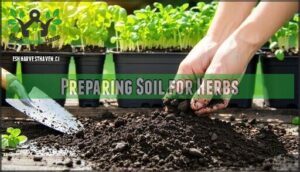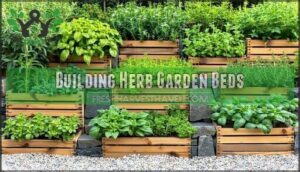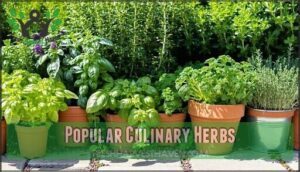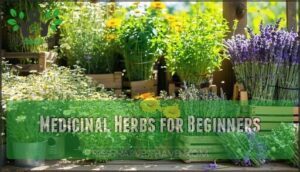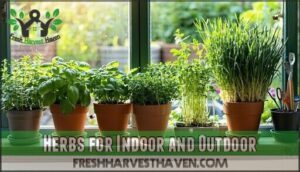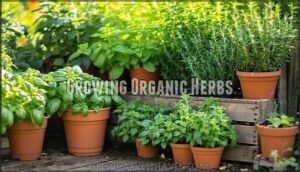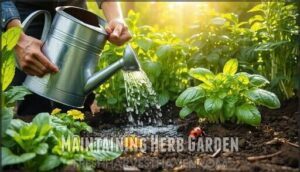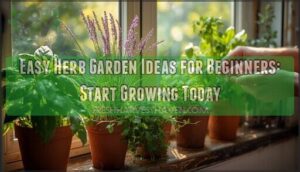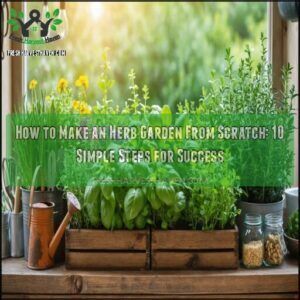This site is supported by our readers. We may earn a commission, at no cost to you, if you purchase through links.
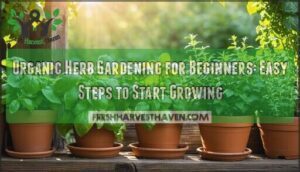
You’ll need well-draining soil, a sunny spot getting 6-8 hours of light daily, and USDA-certified organic seeds or starts. Skip the chemicals—compost and mulch work wonders for healthy growth.
Most herbs actually prefer slightly stressed conditions, so don’t overwater them. Plant after your last frost date, and you’ll be snipping fresh herbs within weeks.
The real secret lies in understanding which herbs thrive together and the timing tricks that separate thriving gardens from struggling ones.
Table Of Contents
- Key Takeaways
- Organic Herb Basics
- Creating Herb Garden
- Herb Selection Guide
- Growing Organic Herbs
- Maintaining Herb Garden
- Frequently Asked Questions (FAQs)
- How to grow a herb garden?
- Which herbs are best for beginners?
- What makes a good herb garden?
- How to grow fresh herbs if you’re a beginner?
- What makes a good organic garden?
- Should you grow your own herbs?
- What is the best starter herb garden?
- How do you start an herb garden for beginners?
- What is the mother of all herbs plant?
- What are the best herbs to grow for beginners?
- Conclusion
Key Takeaways
- Start with foolproof herbs – You’ll have the best success growing basil, mint, parsley, and chives since they’re forgiving and grow quickly, even if you’re still learning proper care techniques.
- Focus on soil drainage and sunlight – You need well-draining soil mixed with compost and 6-8 hours of direct sunlight daily, as most herb failures come from waterlogged roots or insufficient light.
- Don’t overwater your herbs – You should water deeply but infrequently, checking soil moisture with your finger first, since herbs actually prefer slightly stressed conditions over constant moisture.
- Harvest regularly to encourage growth – You’ll get more herbs by pinching flowers and trimming stems frequently, which keeps plants bushy and productive throughout the growing season.
Organic Herb Basics
You’ll discover that organic herbs taste better and are safer for your family than their chemically-treated counterparts.
Starting your herb garden with the right knowledge makes the difference between thriving plants and disappointing failures.
Benefits of Organic Herbs
When you grow your own pesticide-free herbs, you’ll immediately notice their enhanced flavor compared to store-bought alternatives.
Fresh-picked flavor beats store-bought every single time—your taste buds will know the difference instantly.
These healthier options deliver superior nutrient density while supporting your commitment to organic gardening for beginners.
Superior flavor meets peace of mind—organic herbs bring chemical-free goodness straight from your garden to your table.
Your beginner herb garden reduces environmental impact through sustainable practices that build soil health naturally.
Beyond incredible taste, many organic herbs offer medicinal properties for healthy cooking applications.
Starting your organic herb gardening journey means you’ll save money while knowing exactly what goes into your food—no mysterious chemicals, just pure herb benefits from your own backyard.
Many herbs need six to eight hours of sunlight daily.
Choosing The Right Herbs
Selecting the best herbs to grow starts with your climate considerations and space constraints. Focus on beginner varieties like basil, chives, and parsley that match your culinary uses.
Companion planting works well when you group herbs with similar sunlight and water needs. Coastal gardens benefit from herbs that are drought-resistant once established.
Consider these factors for your herb selection:
- Sun-loving herbs like rosemary and thyme thrive in 6+ hours of direct light
- Shade-tolerant varieties such as mint and parsley work in partially shaded spots
- Container-friendly herbs like chives fit perfectly in small spaces and windowsills
Your easy herb garden should reflect what you’ll actually cook with—there’s no point growing sage if you never roast chicken!
Understanding Herb Classification
Understanding botanical families helps organize your herb varieties effectively.
Culinary vs. medicinal herbs often share similar growth habits and herb life-cycles.
Native regions influence care requirements – Mediterranean herbs like rosemary prefer dry conditions, while tropical basil needs consistent moisture.
Annual herbs complete their cycle in one season, perennials return yearly.
This classification streamlines herb selection and herb cultivation, making organic herb gardening manageable for beginner gardening success.
Creating Herb Garden
Creating your herb garden starts with three fundamental steps that’ll set you up for growing success.
You’ll need to pick the perfect spot, prep your soil like a pro, and build beds that make your herbs happy.
Selecting Garden Location
Your herb garden’s success hinges on smart selecting location choices.
Think of it like real estate – sunlight exposure, water access, and soil drainage matter most.
Here’s your location checklist:
- Sunlight requirements: Choose spots with 6-8 hours of direct sun daily
- Water access: Position near hoses or spigots for easy watering
- Soil quality: Guarantee good drainage to prevent waterlogged roots
- Space availability: Allow room for growth and easy harvesting access
Microclimate analysis helps too – herbs love warm, protected spots with gentle air circulation. Consider raised garden beds for improved drainage.
Preparing Soil for Herbs
By building a foundation of proper soil pH and organic nutrients, you’ll set your herbs up for thriving success.
Start with soil testing to determine your pH levels—most herbs flourish between 6.0-7.5. Create the perfect blend using equal parts topsoil, compost amendments, and coarse sand for ideal drainage solutions.
This organic soil preparation mimics Mediterranean conditions that herbs crave. Incorporate 2-6 inches of well-decomposed organic matter into the top soil layer. Organic soil mixes provide slow-release nutrients without over-fertilizing.
Think of it as creating a five-star hotel for your herb roots—they’ll thank you with abundant, flavorful harvests. To guarantee the best growth, remember herbs need nutrient-rich, moist soil.
Building Herb Garden Beds
Great garden beds start with smart bed material choices like untreated cedar or natural stone that’ll last years.
You’ll want proper drainage considerations—add a gravel layer beneath your herb garden soil to prevent soggy roots. Keep size and depth manageable at 8 inches deep for beginners. Position raised beds where sun exposure hits 6+ hours daily.
Consider browsing various herb garden beds for inspiration.
- Drainage considerations: Layer gravel beneath quality garden beds to prevent waterlogged herbs
- Bed material choices: Choose untreated cedar, composite lumber, or natural stone for durability
- Herb garden design: Keep beds 4 feet wide maximum so you can reach the center easily
- Herb garden ideas: Use containers for renters or experiment with tiered raised beds for visual appeal
Herb Selection Guide
Choosing the right herbs for your organic garden can feel overwhelming with so many delicious options available.
Don’t worry—we’ll guide you through selecting the perfect herbs based on your cooking style, growing conditions, and experience level.
Popular Culinary Herbs
Beyond the basics, your organic herb garden becomes a flavor powerhouse with smart culinary choices.
Start with these crowd-pleasers that transform everyday dishes into culinary masterpieces:
- Basil varieties: Sweet basil for classic pesto, Thai basil for aromatic stir-fries
- Oregano types: Greek oregano delivers bold Mediterranean flavor profiles
- Thyme cultivars: Lemon thyme brightens marinades and roasted vegetables
- Parsley benefits: Flat-leaf parsley adds fresh notes to countless culinary pairings
These beginner-friendly herbs adapt to various growing conditions and storage methods.
- Pro tip: Plant herbs you actually cook with—there’s nothing worse than watching unused cilantro bolt while you’re buying dried oregano at the store!
Medicinal Herbs for Beginners
You’ll find medicinal herbs surprisingly easy to grow in your organic garden.
Beginner Medicinal Herbs like chamomile soothe digestive upset and reduce anxiety when brewed into Infusions and Teas. Calendula speeds wound healing and treats skin inflammation – just harvest the entire flower head for maximum potency.
Echinacea boosts immune function, though you’ll wait two years for the most potent roots. Lavender relieves stress and treats minor burns effectively.
These Herbal Remedies thrive with basic herb care – well-draining soil, six hours of sunlight, and regular Herb Harvesting encourages continued blooming. Drying Herbs properly preserves their medicinal compounds for year-round use.
Herbs for Indoor and Outdoor
You’ll master growing herbs organically whether you choose an indoor herb garden or outdoor herb garden.
Light requirements drive your decisions—most herbs need 6-8 hours of sunlight daily.
Container gardening works perfectly for beginners, offering flexibility and better drainage control.
Consider climate considerations and seasonal herbs when planning.
Companion planting maximizes space while herb gardening tips suggest starting small with versatile varieties.
For ideal growth, consider grouping herbs by lighting.
Growing Organic Herbs
Once you’ve set up your herb garden space, it’s time to get those seeds and plants growing.
You’ll learn three key methods that’ll have you harvesting fresh herbs faster than you can say "pesto.
Sowing Seeds and Cuttings
Starting your herb garden from scratch? Seed viability matters—choose fresh organic seeds or healthy cuttings for best results. Quality seed starting beats disappointment every time.
Here’s your game plan:
- Test seed viability by sprouting a few seeds on damp paper towels first
- Use proper propagation mediums like seed-starting mix or perlite for cuttings
- Apply rooting hormones to softwood cutting types for faster root development
- Practice direct sowing with hardy herbs like cilantro and dill
- Master transplanting seedlings by hardening them off gradually outdoors
Planting techniques don’t need to be rocket science. Keep soil consistently moist but not waterlogged, label everything, and celebrate those first green shoots—they’re proof you’re doing it right!
Propagation Methods for Herbs
Once you’ve got seed starting down, herb propagation opens exciting doors.
Cuttings success comes from taking healthy stems and rooting them in water or soil. Division methods work perfectly for clumping herbs—just split established roots into new plants. Layering techniques let stems root while still attached to the parent plant.
| Method | Best Herbs |
|---|---|
| Cuttings | Basil, sage, rosemary |
| Division | Mint, chives, oregano |
| Layering | Thyme, lemon balm |
Rooting hormones boost success rates substantially. Choose your layering propagation approach based on each herb’s natural growth habits.
Caring for Herb Plants
After propagation, your herbs need consistent organic herb care to flourish.
Water deeply but infrequently, checking soil moisture regularly. Use pruning techniques to pinch flowers and trim stems, encouraging bushy growth.
Feeding herbs naturally with diluted compost tea monthly maintains flavor without overdoing it. Monitor sunlight needs—most require six hours daily.
Address common issues like aphids with organic pest control methods. Soil PH matters and should ideally be between 6.0 and 7.5.
Regular maintenance and winterizing herbs with mulch guarantees year-round success.
Maintaining Herb Garden
Once your herbs are established, proper maintenance guarantees they’ll thrive throughout the growing season and beyond.
You’ll need to master three key areas: consistent watering and mulching practices, natural pest and disease management, and timely harvesting techniques that keep your plants productive.
This includes understanding the importance of natural pest and disease management, as well as implementing timely harvesting techniques.
Watering and Mulching Herbs
Your herbs’ watering frequency depends on soil moisture—stick your finger into the earth to check before watering.
Overwatering signs include yellow, droopy leaves and soggy soil.
Choose organic mulch types like straw or shredded leaves for effective garden mulching.
Proper drainage importance can’t be overstated for healthy root systems.
- Morning watering gives herbs time to dry before evening, preventing fungal issues
- Two-inch mulch layer maintains consistent soil moisture while suppressing weeds naturally
- Deep, infrequent watering encourages strong root development better than daily sprinkling
Controlling Pests and Diseases
Pest-and-disease management becomes your garden’s insurance policy against unwanted visitors.
Companion planting with marigolds repels common herb garden pests, while beneficial insects like ladybugs handle aphids naturally. For stubborn invaders, organic pesticides such as neem oil provide effective natural pest control without harmful chemicals.
You can find solutions for effective pest management through specialized suppliers.
| Pest/Disease | Natural Remedies | Disease Prevention |
|---|---|---|
| Aphids | Neem oil spray | Proper plant spacing |
| Whiteflies | Insecticidal soap | Good air circulation |
| Spider mites | Garlic-chili spray | Regular monitoring |
| Fungal diseases | Baking soda solution | Mulching practices |
Focus on organic gardening principles—healthy soil creates resilient plants that resist problems naturally.
Harvesting and Preserving Herbs
Now that you’ve mastered pest control, timing your harvesting herbs makes all the difference.
Harvest early morning when essential oils peak, using sharp scissors above leaf nodes.
Drying methods like small bundles maintain airflow and flavor.
Freezing herbs in ice cube trays with oil preserves potency for months.
Create oil infusions and herb vinegars for year-round cooking with herbs from your organic gardening success.
Frequently Asked Questions (FAQs)
How to grow a herb garden?
Want fresh herbs at your fingertips? Choose a sunny spot with well-draining soil, start with easy herbs like basil and parsley, water regularly, and harvest frequently to encourage growth.
Which herbs are best for beginners?
Start with foolproof favorites like basil, mint, and parsley—they’re practically bulletproof for new gardeners. Add chives and thyme for variety; they’ll forgive your learning curve while delivering fresh flavors.
What makes a good herb garden?
Studies show 80% of successful herb gardens share three key features: you’ll need well-draining soil, 6-8 hours of daily sunlight, and easy access for harvesting your fresh herbs regularly.
How to grow fresh herbs if you’re a beginner?
Choose easy herbs like basil, mint, and parsley. Give them six hours of daily sunlight, well-draining soil, and water when the top inch feels dry.
What makes a good organic garden?
Like fertile soil that nurtures every seed, a thriving organic garden starts with healthy, chemical-free earth enriched with compost.
You’ll need proper drainage, full sunlight, and diverse plants that naturally support each other’s growth, creating a thriving environment.
Should you grow your own herbs?
You’ll save money, enjoy fresher flavors, and control what chemicals touch your food. Growing herbs teaches you gardening basics while providing ingredients that taste better than store-bought varieties.
What is the best starter herb garden?
Before smartphones ruled our pockets, folks grew kitchen windowsill gardens with simple herbs. Start with basil, parsley, chives, and mint—they’re forgiving, fast-growing, and useful for cooking everyday meals.
How do you start an herb garden for beginners?
Start your herb garden by picking a sunny spot with well-draining soil. Plant beginner-friendly herbs like basil, parsley, and mint in containers or raised beds for easy maintenance.
What is the mother of all herbs plant?
The "mother of all herbs" typically refers to oregano, though some consider it basil.
You’ll find oregano’s robust, earthy flavor and medicinal properties make it incredibly versatile for cooking and natural remedies.
What are the best herbs to grow for beginners?
Basil, parsley, and mint are perfect beginner herbs since they’re forgiving and grow quickly. You’ll also find success with chives, cilantro, and thyme—they’re practically bulletproof for new gardeners.
Conclusion
Your herb garden will soon become your kitchen’s best friend, sprouting fresh flavors right outside your door.
Starting organic herb gardening for beginners doesn’t require a green thumb—just patience and consistency.
You’ve learned the essentials: choosing hardy herbs, preparing nutrient-rich soil, and maintaining proper care routines.
Remember that herbs actually prefer being slightly neglected over pampered, and with these fundamentals, you’ll transform from novice gardener to herb harvesting pro in just one growing season, becoming your kitchen’s new best friend with fresh flavors.
- https://www.gardenary.com/blog/the-best-herbs-to-grow-at-home-for-beginner-gardeners
- https://highlandmoss.com/plant-care/soil/premium-herbs-potting-soil/
- https://www.starkbros.com/growing-guide/how-to-grow/garden-plants/herbs/soil-preparation
- https://ucanr.edu/site/uc-master-gardeners-santa-clara-county/herb-gardening-basics
- https://www.azurefarmlife.com/farm-blog/herbs-and-flowers-for-organic-pest-control-in-the-garden


